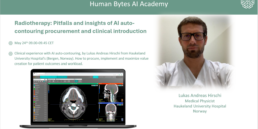We’re excited to announce that 13 abstracts have been accepted at ESTRO this year. We are deeply grateful for the outstanding collaborations with our clinical and academic partners, whose contributions are instrumental in advancing the integration of AI into Radiotherapy workflows.
Advances in AI Autosegmentation
AI-driven autosegmentation tools demonstrated performance on par with human experts in multiple studies. In head and neck (HN) cancer treatment, AI models for vessels contouring achieved good agreement with manual contours and a clinical acceptability score of 97% (Gardeanu et al). These findings show AI tools not only match expert performance but improve consistency of contouring.
Furthermore, a fully automated workflow combining deep learning-based contouring and auto-planning solutions was evaluated in laryngeal cancer (Westermayer et al.) demonstrating improved consistency in the nodal target and organs-at-risk delineation. This advancement is particularly relevant to the broader challenges of head and neck (HN) cancer treatment planning, which requires strict dose constraints to multiple organs at risk, directly impacting patients’ quality of life. In this context, pharyngeal sparing has emerged as a key focus, with a recent study investigating the feasibility of reducing radiation doses to the pharyngeal muscles while maintaining overall plan quality (Lurtz et al.).
MRI Outpaces CT in Delineation Accuracy
Comparative studies found MRI imaging providing superior visualization and notably faster delineation compared to contrast-enhanced CT for organs-at-risk in HN region (Brezae et al). These results bolster ongoing efforts to develop fully automated MRI-based workflows.
Next-Generation Tools for Tumor Monitoring
Innovative tools for tumor segmentation, including glioblastoma and brain metastases, achieved remarkable precision with scores DSC scores up to 0.88 (Satragno et al.) and 0.78, respectively (Roux et al.). Such evidence supports their integration into clinical routines as reliable tools for tracking tumor growth and treatment response.
Towards Autonomous Radiotherapy Planning
Smart Automation in Prostate Radiotherapy
Prunarety et al. conducted an extensive end-to-end study investigating a fully automated planning solution for prostate cancer. Their findings demonstrated that the pipeline produced high-quality, clinically acceptable plans comparable to manually created ones, with the added benefit of improved rectum sparing. With a seamless ‘one-click’ output, the solution’s clinical integration has the potential to greatly improve efficiency in the treatment planning process. These findings are confirmed in another study, where the automated planning solution was accepted for clinical use (Khatib et al.).
Informed decision making for plan adaptation
A new study has evaluated AdaptBox, TheraPanacea’s AI-driven software designed to streamline offline adaptive radiotherapy (Ahmad et al). AdaptBox generates synthetic CTs (sCT) from Cone-Beam CTs (CBCTs), automates organ segmentation, and calculates dose distribution based on the initial treatment plan. Researchers analyzed 68 sCTs from nine lung cancer patients and found that the software demonstrated strong organ contouring performance and improved image quality, despite minor artifacts and some inaccuracies at lung-liver boundaries. The study concluded that AdaptBox provides a reliable tool for monitoring dose deposition, supporting its use in determining when treatment plan adjustments are necessary.
Image generation and AI models’ architectures for dose prediction
Synthetic CT solutions derived from MRI may leverage AI-driven MRI-based sCT generation for brain proton therapy planning (McNeil et al.). Additionally, an alternative approach utilizing body surface data (Potel et al.) has demonstrated promising potential for generating sCT solely from external contours, thereby reducing patient radiation exposure.
Transformers are a cutting-edge AI model architecture, showing comparable performance to traditional U-net models in dose prediction, though with increased training time. Researchers suggest future focus on multi-modal integration to harness full potential (Dubois et al).
All these exciting findings highlight a pivotal moment in radiotherapy, where AI and automation are no longer future concepts but present-day clinical tools. From enhanced precision in organ delineation to automated treatment planning and adaptive workflows, these innovations are driving a new standard of care—one that is more consistent, efficient, and personalized. As these technologies continue to mature, they promise to transform cancer treatment worldwide, improving outcomes while reducing burdens on healthcare professionals and patients alike.
List of Abstracts
- Ana-Maria Gardareanu et al. Evaluation of an AI-based autosegmentation software for head and neck vessels contouring
- Sevgi Emin et al. The performance of deep learning tools, trained on the same dataset, for autosegmentation of challenging organs-at-risk in the thoracic region
- Adelina Brezae et al. Comparison between T1-, T2- and T1 StarVibe-weighted MRI sequences and contrast-enhanced CT based delineation of organs at risk in head and neck radiotherapy
- Camilla Satragno et al. Quantitative evaluation of tumor subregion automatic segmentation in glioblastoma for monitoring of growth patterns
- Anne-Charlotte Roux et al. Evaluating Inter-Expert Variability and Model Performance in Automated Brain Metastasis Segmentation
- Jessica Prunaretty et al. Quantitative evaluation of a fully-automated planning solution for prostate-only and whole-pelvic radiotherapy
- Youssef Khatib et al. Evaluation of an Artificial Intelligence-Based Industrial Solution for Automated Prostate Planning
- Moritz Westermayer et al. Evaluation of an almost-autonomous dosimetric workflow for the management of laryngeal cancer in radiotherapy
- Andreas Lurtz et al. Active pharyngeal sparing for photon head & neck treatment plans: a feasibility plan study
- Isha I. Ahmad et al. Evaluation of synthetic CTs generated out of CBCTs to determine the need of plan adaptation in the context of offline adaptive lung radiation therapy
- Luka MCNEILL et al. Leveraging MRI-Based AI-Driven Synthetic CT Generation for Brain Proton Therapy Planning
- Jules Potel et al. Synthetic CT Generation from Body Surface Data
- Paul Dubois et al. Evaluation of transformer architecture for deep dose prediction in radiotherapy
Related Posts
25 June 2024
Unlocking the Potential of AI Auto-Contouring in Radiotherapy at HELSE Bergen [WEBINAR]
Clinically Relevant AI in Radiation…




